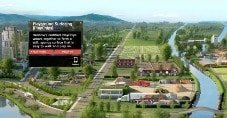Archive for month: October, 2016
Sustainable Development Goals – Goals for Green Developers
/0 Comments/in Environment, Municipal and Infrastructure Journal, Sustainable Development /by Tanya Richards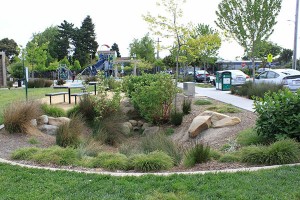 Sustainable Development Goals – Goals for Green Developers
Sustainable Development Goals – Goals for Green Developers
Protecting the natural environment can be a tricky situation especially when you consider human development. At times, the environment works against itself causing health problems for humans, but this is where sustainable development comes in. There has to be a balance between the two in order for this concept to work for future needs. Here are some Sustainable Development projects that work with the environment in a safe, collaborative way.
1. Eco-friendly construction
Eco-friendly construction involves building projects that are not harmful to the environment. In addition to that, the construction project makes efficient use of the available resources. This means that the projects are environmentally friendly and ecologically responsible in planning and actual construction.
This kind of construction, also called green building, is based on the premise that construction in most cases is hazardous in terms of the energy used, distance products have to travel to be used onsite and the environmental impact on the inhabitants and the ecosystem. The following are some of the examples of such construction;
- Recycled shipping containers can be used to build residential houses. This is done to minimize carbon emissions to preserve the environment. Human beings are also able to live in such houses without any health hazard.
- Use of Modcell insulation technology. This technology is used to build carbon-negative structures by use of straw bale. The structures have the best thermal performance rating, are fire-resistant, and straw is a breathable material. Hence they are conducive for human beings and at the same time, they are eco-friendly.
- Clay-based buildings – These structures are formed out of clay mixed with water to form very strong walls. This is cost effective and suitable in areas that are hot and dry.
In green building technology, the focus is usually on the conservation of the environment while at the same time preserving human life. The buildings are designed with bio-architecture technology that minimizes health hazard to humans and creates a balance in sustainable development.
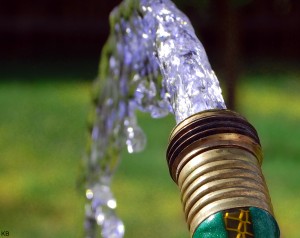
2. Eco-friendly water conservation
Water conservation is one of the sustainable development projects that works well to protect both the environment and human life. Instead of using chemical substances to clean and treat water, there is use of biological waste water treatment and re-use that are non-harmful. For example, constructing an aquatic plant-based system that easily enables microorganisms to digest sewage systems and clean greywater. They can enable residents to have clean water for household use and farming. Secondly, rainwater can also be collected, recycled and used in farming and residential settings. Eco-friendly water conservation is based on the sustainability framework to minimize water wastage and provide clean water for human beings.
3. Use of renewable energy
Renewable energy being one of the Sustainable Development Goals has led to projects that reduce the emission of carbon dioxide and hence reducing the impact of global warming. Renewable energy projects are geared towards having clean, reliable and affordable electricity for both commercial and household use. The affordability of these projects allows rural communities, especially in developing countries to have access to electricity and hence improve their lifestyles.
The use of solar energy, for example, is eco-friendly and thus protects both human life and the environment. Solar energy can be used in households and factories. This helps in creating a green environment by avoiding harmful sources of energy.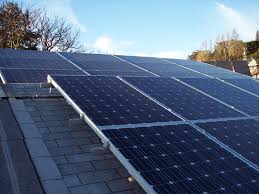
In as much as protecting the natural environment and protecting human life poses a challenge on how to create the balance, there are some interventions that can be made enhance sustainable development. Indeed, sustainable development is a collective responsibility that requires everyone’s effort to make the world a suitable home for the present and future generations.
Save
5 Steps for Erosion Control on Steep Slopes and Embankments
/34 Comments/in Erosion Control, Green Infrastructure, Slope Stabilization /by Tanya RichardsFor the most part, soil will stay put. However, on steep slopes and embankments, there is the elevated risk of erosion. It is essential to put as much effort as possible into actions that will stop the soil from washing away. This is because not only could this make the area that has been eroded barren, but it could also adversely affect water supply and introduce pollutants. Additionally, it could take decades to rebuild even the initial layer of topsoil, so it essential to have some insight on how to keep topsoil in place.
There are many methods that could be used to help prevent or stop erosion on steep slopes, some of which are listed below.
Plant Grass and Shrubs
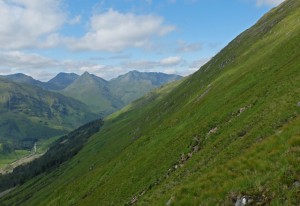 Grass and shrubs are very effective at stopping soil erosion. This is primarily because plant roots tend to hold soil together, making it harder to erode. The leaves of the plants also help to reduce the velocity of raindrops falling on the ground, making it harder for them to dislodge the soil and erode it. Ornamental grass and low, spreading shrubs work best as they leave no areas of bare soil exposed to the elements.
Grass and shrubs are very effective at stopping soil erosion. This is primarily because plant roots tend to hold soil together, making it harder to erode. The leaves of the plants also help to reduce the velocity of raindrops falling on the ground, making it harder for them to dislodge the soil and erode it. Ornamental grass and low, spreading shrubs work best as they leave no areas of bare soil exposed to the elements.
Use Erosion Control Blankets to Add Vegetation to Slopes
There are many varieties of fiber, biodegradable, and compost blankets/mats on the market today, and they have all been designed with one aim; to minimize the effects of water erosion on slopes and embankments. Rolled mats are usually made from mulch that is held together by a fiber mesh. They degrade slowly, allowing vegetation that may have been grown in the area to grow and take over the job of protecting the soil from erosion when the mats have finally degraded completely. Compost erosion control blankets act similarly to mulch products but provide organic nutrients that promote vegetation growth, even in areas where germination, moisture management and irrigation could be challenging.
Build Terraces
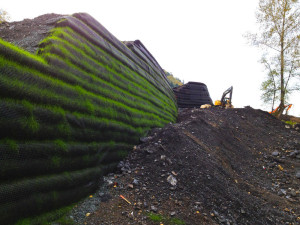 If you are planning on trying to control the erosion on very steep slopes or embankments, sometimes planting vegetation may just not cut it as the slope may be too steep to support anything other than the hardiest grass due to the rapid rate of erosion. If this is the case, you should consider building terraces to help slow down erosion as the vegetation takes hold. Terraces can be made out of anything, from wood to concrete blocks to bio-mechanical solutions like the Cascadia Green Wall that uses Filter Soxx with natural mulch/seed filling and geogrid for structural stability. The beds that are created by the terraces can then be used to plant vegetation such as ornamental plants or grass.
If you are planning on trying to control the erosion on very steep slopes or embankments, sometimes planting vegetation may just not cut it as the slope may be too steep to support anything other than the hardiest grass due to the rapid rate of erosion. If this is the case, you should consider building terraces to help slow down erosion as the vegetation takes hold. Terraces can be made out of anything, from wood to concrete blocks to bio-mechanical solutions like the Cascadia Green Wall that uses Filter Soxx with natural mulch/seed filling and geogrid for structural stability. The beds that are created by the terraces can then be used to plant vegetation such as ornamental plants or grass.
Create Diversions to Help Drainage
Depending on the incline of the slope or embankment, one of the most effective ways to help prevent erosion is to create diversions which will channel excess water down the slope along a predetermined path. One of the simplest ways to do this is to create open ditches or drains by simply digging along the slope at regular intervals. Use of pipes and gutters is also very effective, and work just as well as natural drains when designed and installed properly.
Importance of a Sustainable Development Strategy
/0 Comments/in Environment, Sustainable Development /by Tanya RichardsWe Agree – It Is Important to have a Sustainable Development Strategy
At Denbow, we know the importance of a Sustainable Development Strategy. Sustainable development is not a buzz word. It’s a real and important aspect we all should consider and include in our business strategy. When we all look at how we engage our business and the impact it has on the environment and our communities, it is easy to see the need for a sustainable development strategy. This will ensure that we all come to a better understanding about how our business, regardless of how big or small, impacts the the environment and implementing a core Sustainable Development Strategy.
We felt it was important to share this introduction to what our Federal Government’s Sustainable Development Strategy will be as they implement their listed goals over the next three years. We hope this can be a baseline for more discussions regarding sustainable development and it’s importance within all of our core business strategies.
What is the Federal Sustainable Development Strategy?
The Federal Sustainable Development Strategy (FSDS) is our primary vehicle for sustainable development planning and reporting. It sets out our sustainable development priorities, establishes goals and targets, and identifies actions to achieve them.
The 2008 Federal Sustainable Development Act provides the legal framework for developing and implementing the FSDS. It requires the Minister of Environment and Climate Change to consult on and table a whole-of-government strategy every three years.
Under the act, 26 departments and agencies are responsible for preparing their own sustainable development strategies that comply with and contribute to the FSDS. Fifteen additional organizations contribute to the FSDS voluntarily.
The 2016–2019 FSDS is the third whole-of-government strategy prepared under the act. It outlines what we will do to promote clean growth, ensure healthy ecosystems and build safe, secure and sustainable communities over the next three years.
Explore our goals
Thirteen aspirational goals support our sustainable development vision and reflect the Canada we want:
Effective action on climate change
A low-carbon economy contributes to limiting global average temperature rise to well below two degrees Celsius and supports efforts to limit the increase to 1.5 degrees Celsius
Low-carbon government
The Government of Canada leads by example by making its operations low-carbon
Clean growth
A growing clean technology industry in Canada contributes to clean growth and the transition to a low-carbon economy
Modern and resilient infrastructure
Modern, sustainable, and resilient infrastructure supports clean economic growth and social inclusion
Clean energy
All Canadians have access to affordable, reliable and sustainable energy
Healthy coasts and oceans
Coasts and oceans support healthy, resilient and productive ecosystems
Pristine lakes and rivers
Clean and healthy lakes and rivers support economic prosperity and the well-being of Canadians
Sustainably managed lands and forests
Lands and forests support biodiversity and provide a variety of ecosystem services for generations to come
Healthy wildlife populations
All species have healthy and viable populations
Clean drinking water
All Canadians have access to safe drinking water and, in particular, the significant challenges Indigenous communities face are addressed
Sustainable food
Innovation and ingenuity contribute to a world-leading agricultural sector and food economy for the benefit of all Canadians
Connecting Canadians with nature
Canadians are informed about the value of nature, experiencing nature first hand, and actively engaged in its stewardship
Safe and healthy communities
All Canadians live in clean, sustainable communities that contribute to their health and well-being
EcoBlanket on slopes at Albion
/0 Comments/in Construction Landscape Journal, Environment, Erosion Control, Slope Stabilization, Sustainable Development /by Tanya RichardsSustainable Development & Freshwater Quality in Canadian Rivers
/0 Comments/in Construction Landscape Journal, Environment, Sediment Control, Slope Stabilization, Streambank Restoration, Sustainable Development /by Tanya RichardsIn our quest for sustainable development, a major consideration must be maintaining the water quality of our streams, rivers and other water sources. These water sources support plant and animal habitats, as well as human commercial, industrial and recreational activities.
The following article on freshwater quality trends in Canadian rivers was originally posted on the Environment Canada website but has been reproduced below for your convenience. As mentioned below, a key factor affecting the quality of water in Canadian rivers is the amount of rain and snowfall during the year, which can carry soil and pollution through runoff and leaching into the rivers. The way that construction development is performed greatly affects the sustainability of our rivers for the long term.
As the article concludes, one important factor in reversing water quality trends in our rivers is to build the health of stream banks by planting native vegetation and trees. Another important part of ensuring the long-term establishment of this vegetation is to rejuvenate and stabilize the soil with compost-based soils and growing mediums, as with Denbow’s Terraseeding service.
Freshwater Quality in Canadian Rivers
The Freshwater Quality in Canadian Rivers indicator is designed to provide an overall measure of the ability of select rivers across Canada to support aquatic life.[1] It integrates multiple pressures from human activity upstream of water quality monitoring sites to present freshwater quality in the regions where the majority of Canadians live.[2]The indicator focuses on rivers with higher risks to water quality and provides Canadians with an indication of human impacts on freshwater quality.
For the 2010 to 2012 period, freshwater quality in Canadian rivers where human activities are most concentrated was rated:
- excellent or good at 45% of monitoring sites,
- fair at 37% of sites,
- marginal at 16% of sites, and
- poor at 2% of sites.
Overall, freshwater quality in Canadian rivers can maintain healthy river ecosystems.
National freshwater quality indicator, Canada, 2010 to 2012 period
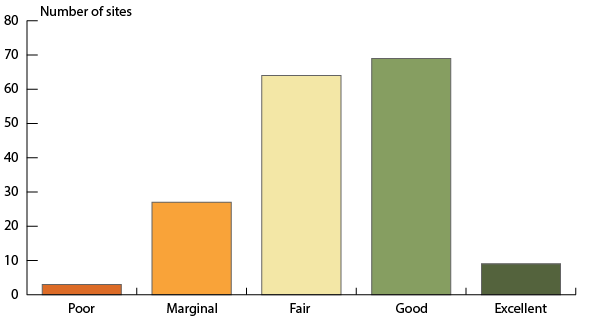
The bar graph presents freshwater quality rating in rivers selected to be representative of the regions of Canada where human activities are most concentrated for the period 2010 to 2012. The bars show the number of sites where freshwater quality was rated excellent (9), good (69), fair (64), marginal (27) and poor (3). Ratings are based on data from 172 monitoring sites.
Note: Freshwater quality was assessed at 172 sites on select rivers throughout 16 of Canada’s drainage regions where human activity is most intensive using the Canadian Council of Ministers of the Environment’s Water Quality Index.
Source: Data assembled by Environment Canada from federal, provincial, territorial and joint water quality monitoring programs.
Clean freshwater is an essential resource. It provides habitat for aquatic plants and animals, supports many commercial and industrial uses, and is at the heart of many recreational activities. Impaired water quality can undermine both aquatic ecosystem health and economic activities, such as fisheries, tourism and agriculture.
Freshwater quality varies naturally across Canada because of the country’s diverse geology and climate. It is further shaped by the ways in which people have developed the land around rivers and lakes. Each freshwater quality monitoring site has its own unique geography and set of human pressures.[3]
The rivers included in the indicators are selected to be representative of the drainage regions in Canada where human activities, such as industry, agriculture, urban growth and recreation, are most concentrated. The potential impacts of these human activities mean that these rivers are generally considered to have a higher potential for water quality impairment. At each site, physical properties of water, such as temperature, and levels of chemical substances, such as nutrients and metals, are measured and compared to freshwater quality guidelines. The more often a freshwater quality measurement is above its guidelines, the lower the freshwater quality rating will be.
Change in the national freshwater quality indicator through time
Between 2003–2005 and 2010–2012, there was an increase in the percentage of sites rated good or excellent and a decline in the percentage of sites rated poor or marginal.
Overall, the freshwater quality scores have:
- improved at 11 sites;
- declined at 4 sites; and
- showed no change at the remaining 85 sites.
National freshwater quality indicator, Canada, change between 2003–2005 and 2010–2012
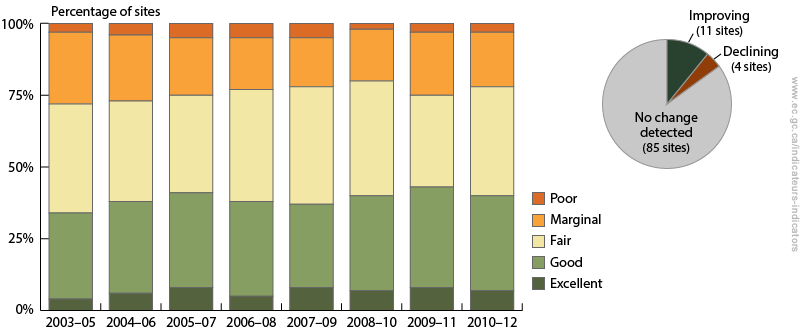
The bar graph shows the percentage of sites where freshwater quality was rated excellent, good, fair, marginal and poor between 2003–2005 and 2010–2012. The inset pie chart shows the number of sites where the freshwater quality indicator has improved, where it has deteriorated, and where no change was detected. Between 2003–2005 and 2010–2012, the freshwater quality indicator rankings have improved at 11 sites and declined at four sites. No change was detected at 85 sites.
Note: Change in the indicator between the 2003–2005 and 2010–2012 periods was assessed at 100 sites in 16 drainage regions across Canada where historical data are available. For each site, change in the indicator was assessed using a consistent set of water quality guidelines and parameters through time.
Source: Data assembled by Environment Canada from federal, provincial, territorial and joint water quality monitoring programs.
Freshwater quality is affected by rain and snow which controls how much water runs off the land or leaches through soils. It is also affected by pollution released directly into it or that travels across land and through the air. Urban growth, agricultural practices and industrial development impact how water moves across the land and change water quality along the way. These multiple pressures on water quality mean freshwater quality trends are slow to change.
The decline in water quality can be reversed by upgrading wastewater treatment plants, adopting environmental farming practices, or planting native vegetation, such as trees, along rivers.
Save
Erosion Control on Steep Slopes and Embankments
/6 Comments/in Environment, Erosion Control, Municipal and Infrastructure Journal, Sediment Control, Streambank Restoration, Water Abatement /by Tanya RichardsErosion Control
As land development happens in hilly countryside, more erosion control on steep slopes and embankments is needed. Especially in areas that experience heavy rainfall. Steep slopes and embankments that have no vegetation or cover are especially vulnerable to erosion issues. Erosion can cause damage to not only the landscape, but any infrastructure surrounding the project. It is important to protect the hillside from erosion during and after the project is complete.
Erosion is basically the displacement of soil from one area to another. On steep slopes and embankments erosion is caused primarily by water, especially by heavy rainfall. Rain that falls onto the exposed ground dislodges soil particles which are then carried away down the slope by the flowing water. However, it is the resulting destabilization of slope that creates an even greater danger as rocks and trees roots become exposed.
There are several ways of controlling erosion on steep slopes and embankments.
 Natural Solutions
Natural Solutions
The most effective, natural way to control soil erosion on steep slopes and embankments is to plant vegetation. Not only will the grass, fescue and leaves help to slow down raindrops as they fall, the roots of the plants will also help to hold the soil together, making it harder for water to wash it away.
However, when planting vegetation on a slope to stop erosion, you need to keep in mind that what you’re planting is just as important as the planting. Though grasses can create a groundcover that can absorb some moisture, they have less effective storm water filtration ability compared to native ground cover. Various typical erosion control seed specifications are available as well as custom seed blends to mimic the native grasses in the area.
Artificial Solutions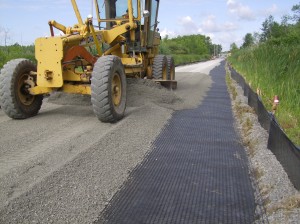
Other than planting vegetation, there are also a variety of artificial solutions you can use. For instance, the use of geomats has become popular over the last few years. Geomats are water permeable polymers that are used to help fix soil elements, grass and small plant roots, and have been shown to work extremely well, especially on barren slopes that have no vegetation. There are even biodegradable geomats that are now being produced that are designed to prevent erosion and give freshly planted vegetation a chance to grow.
Building Terraces
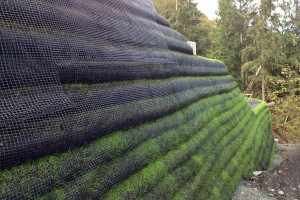 Building terraces is also another way to help prevent soil erosion. When most people think of terraces as a method of erosion control, some may think of the incas in Peru. There the natives implemented the early methods of erosion control on the Andes mountains for many centuries. Terrace walls help to hold soil in place while providing a convenient surface to plant a variety of plants. Building terraces can be as simple as using a couple of wooden blocks to create a terrace wall, or it could be more sophisticated and involve the use of engineered stones, concrete retaining wall blocks or a living green wall solution.
Building terraces is also another way to help prevent soil erosion. When most people think of terraces as a method of erosion control, some may think of the incas in Peru. There the natives implemented the early methods of erosion control on the Andes mountains for many centuries. Terrace walls help to hold soil in place while providing a convenient surface to plant a variety of plants. Building terraces can be as simple as using a couple of wooden blocks to create a terrace wall, or it could be more sophisticated and involve the use of engineered stones, concrete retaining wall blocks or a living green wall solution.
Soil Composition Enhancement
You could also control erosion by controlling the soil itself. As heavy rain tends to be the biggest culprit for soil erosion on slopes and embankments, by controlling the composition of the soil, you  could control the effect that water has on it and therefore the likelihood that it will be eroded. Soil that is high in organic material tends to absorb more water, therefore, using organic material such as compost, aged mulch, or a manure can go a long way in preventing soil erosion.
could control the effect that water has on it and therefore the likelihood that it will be eroded. Soil that is high in organic material tends to absorb more water, therefore, using organic material such as compost, aged mulch, or a manure can go a long way in preventing soil erosion.
The best solution (or multiple solutions) is best determined by evaluating each slope individually.
Save


